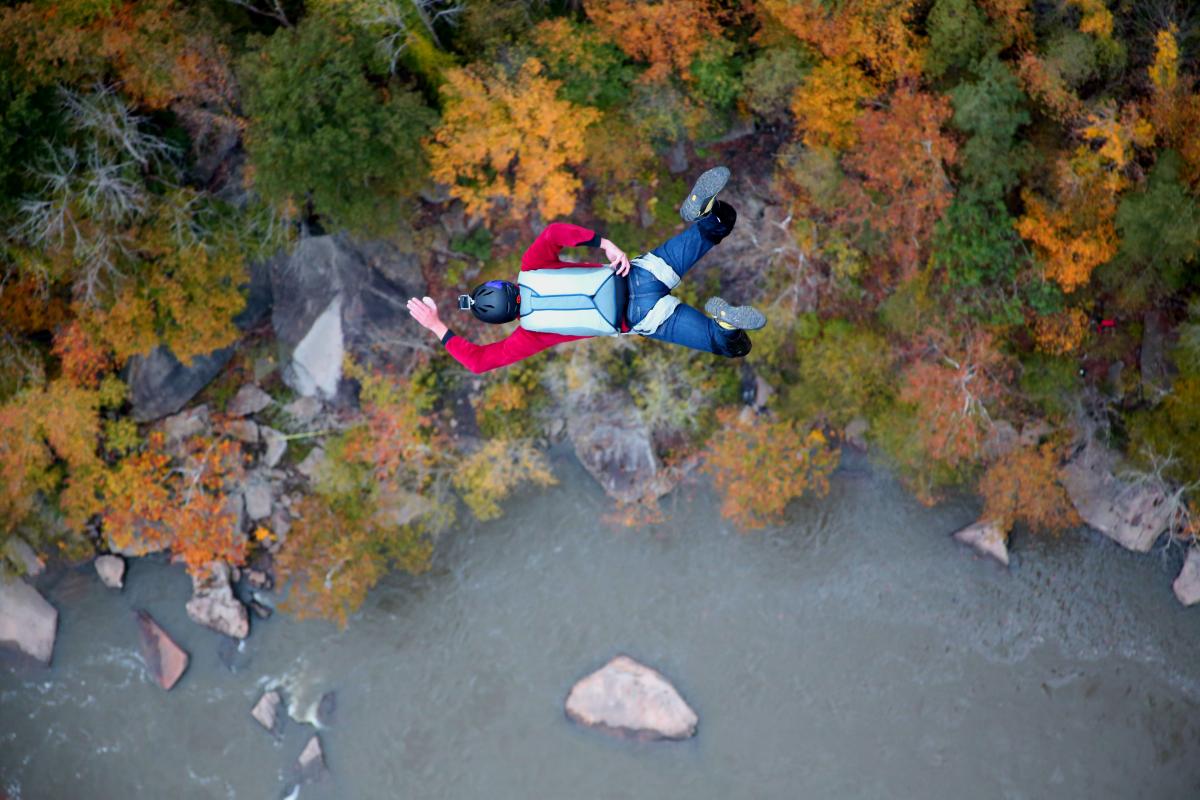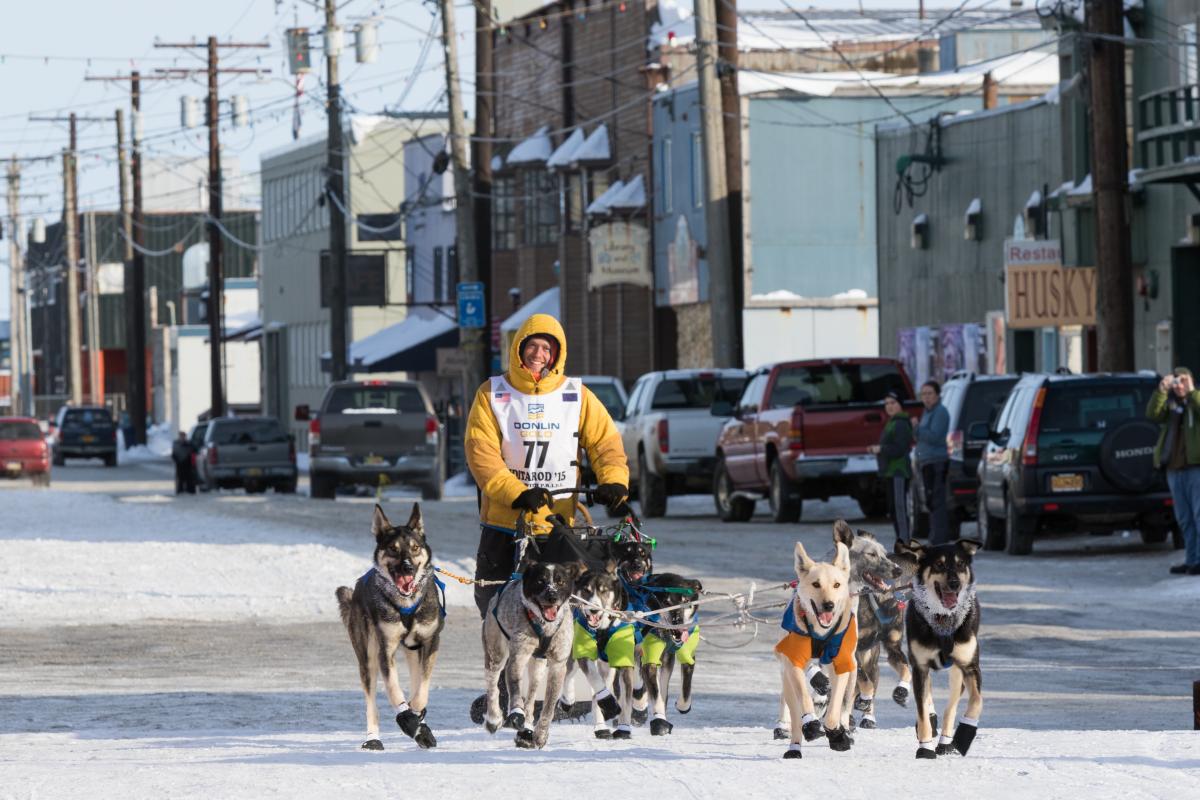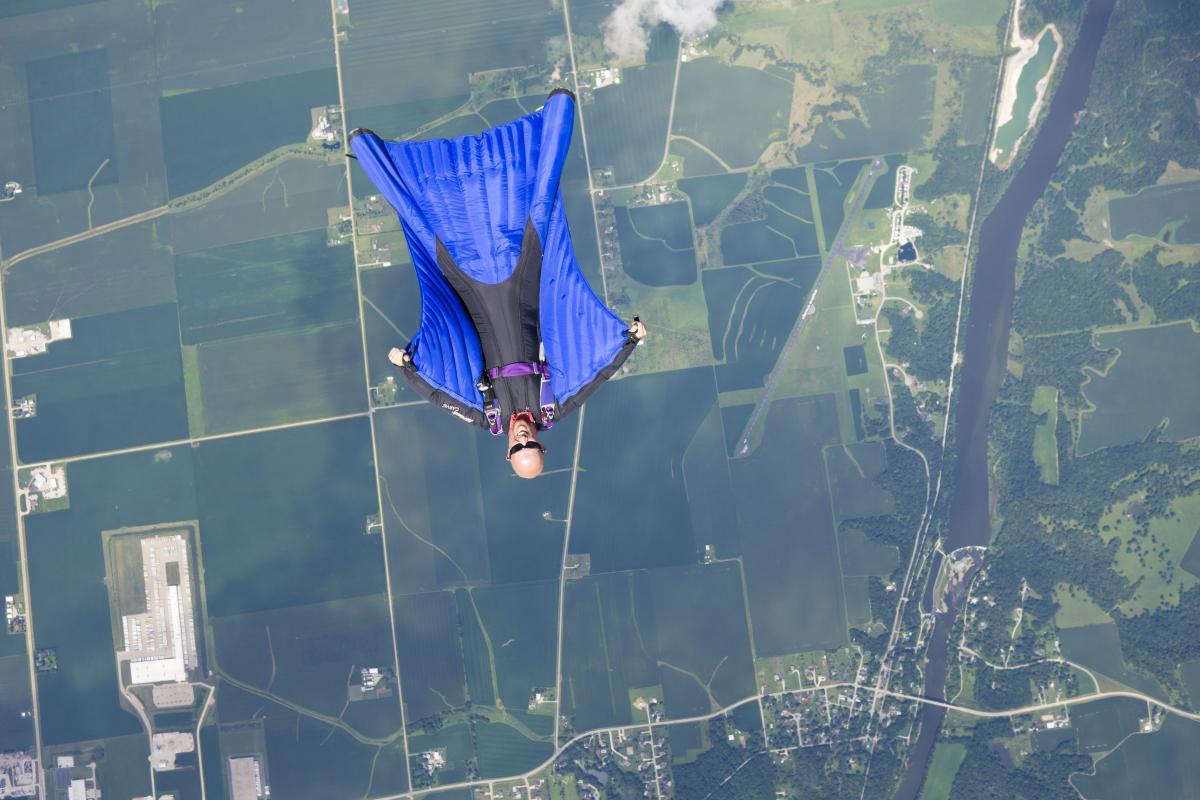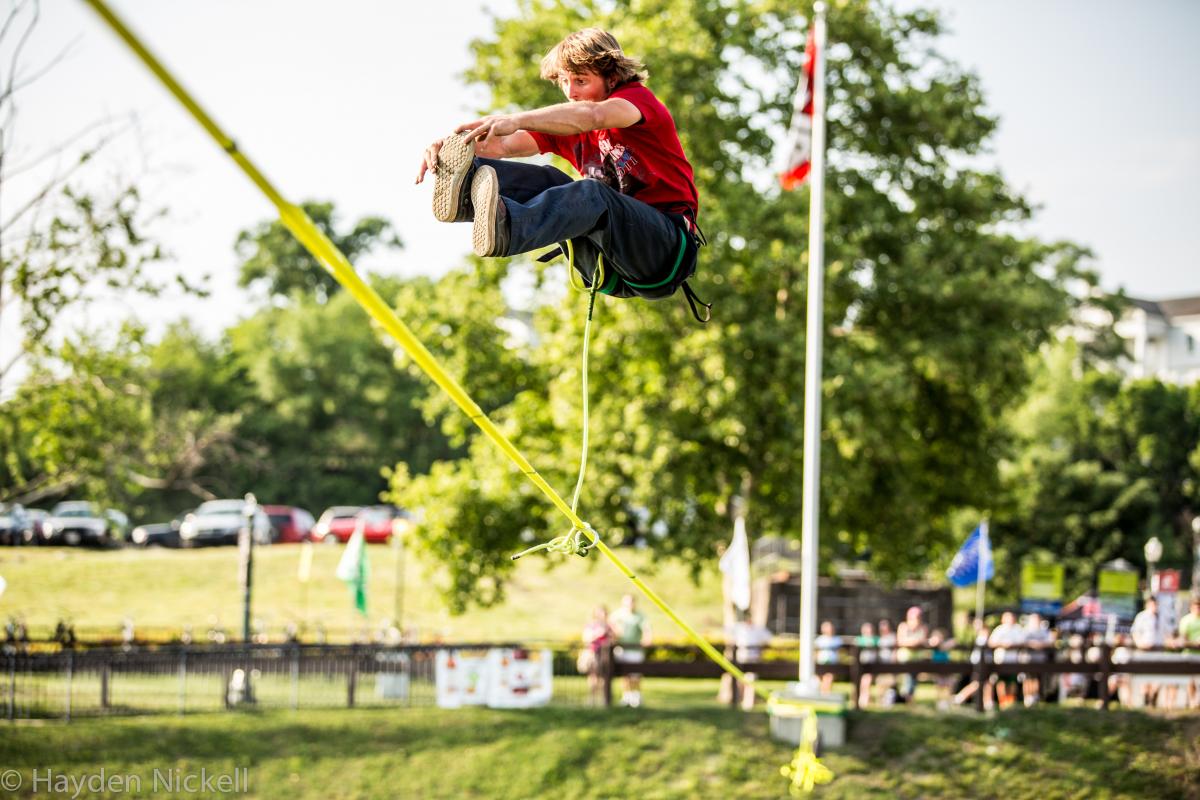 |
| Chris Fehn '12 BASE jumps into the New River Gorge in Fayetteville, West Virginia. (Photo courtesy of Chris Fehn) |
Mines engineers are making a name for themselves in the growing world of extreme sports.
For Mickey Wilson ’11, MS ’12, it’s just another day at the office.
Sporting baggy jeans, a black ball cap and an intensely focused look, the physics and metallurgical engineering graduate steps onto a 2-inch wide strap of webbing suspended a dizzying 460 feet above the blinking Las Vegas Strip. Guests at the nearby Mandalay Bay casino look up nervously as he moves toward the center, riding the line surfer-style and wildly rocking it back and forth. He brie y hops on one foot, then gracefully (and purposely) slips off, tumbling ground-ward. The audience gasps. His safety rope catches him. He climbs back up, grin spreading across his face. And he begins again, joining three other professional slackliners hired to put on tonight’s hair-raising show.
What does any of this have to do with engineering? Let Wilson count the ways.
“Just setting up a slackline safely is an engineering problem,” says Wilson, whose job has required him to tiptoe over an active volcano in Italy, traverse a cavernous limestone valley in Spain and perform high- flying acrobatics for the Prince of Dubai. “And what you do with your body up on that line—it’s all physics.”
Surprisingly, Wilson’s career choice isn’t as rare as you’d think. From Alan Stevens ’12, an environmental engineering graduate turned professional musher; to Maureen Sweet ’15, a chemical engineering graduate turned professional half-pipe snowboarder; to
Derek Parks ’05, MS ’10, a computer scientist who moonlights as a wingsuit skydiving instructor, stories abound of Mines alumni using their engineering backgrounds to excel (even make a living) at extreme sports.
Some of these athletes say their appetite for adrenaline, and the epic kayaking, climbing and mountaineering around Golden, were some of the things that lured them to Mines.
Others say they gravitated toward their grueling, exceedingly risky pastimes as a mind-clearing distraction from the school’s academic rigors. And many say the scientist’s mindset is a perfect t for sports in which calm, analytical problem-solving in tense times can mean the difference between life and death.
“Risk management was a big part of our curriculum at Mines,” says Stevens. “Maybe it wasn’t about jumping out of airplanes or trying to not freeze to death when you’re out on the frozen ocean, but it translates well anyway.”
From Summer Adventure to Life’s Work
 |
| Alan Stevens '12 approaches the finish line in Nome, Alaska, as he completes the 2015 Iditarod trail sled dog race. (Photo by Hideo Sata) |
Alan Stevens knew little about Alaska and less about sled dogs when, after graduating, he spotted a job advertisement for “a poop scooper for 300 dogs.” He worked at a tourist dog- sledding camp, accessible only by helicopter, on Alaska’s Mendenhall Glacier. He assumed that by fall, he’d come home and get a “real” job.
“I thought of it as a big summer adventure,” he says. But during his time on the glacier, he became enamored with the athleticism of the huskies and the ancient form of transportation they provided to some of the world’s wildest places. By summer’s end, he set his sights on the frigid 1,000-mile Iditarod sled- dog race from Anchorage to Nome. He reached out to four-time champion Martin Buser for mentorship, began to amass a team of huskies and spent three cold and dark years training.
He used his engineering skills every step of the way, he says, from building himself a 31-pound carbon fiber sled to designing tiny strain gauges (wired into each dog’s harness) to measure in real-time how much weight each was pulling. When it came time to packing and arranging for the drop-shipping of 2,700 pounds of supplies (mostly dog food) along the Iditarod Trail in March 2015, his eye for efficiency came in handy. His time management skills also helped, as he cared for 16 dogs, stopping for six-hour breaks to methodically examine each of their 64 feet, rub every shoulder, check every harness, melt snow and prep a warm stew for them and try to find time to feed and dry himself before packing up to go again.
At one point, he got lost and had to hunker down in -68 degree temperatures, blanketed in falling snow. At another, the team took 15 hours to scratch its way across the frozen ice of Norton Bay—visibility near zero. (It typically takes six hours.)
“When I was facing extreme diversity, I’d just stop, take a few minutes to think about what resources I had available to me and problem solve. I learned that at Mines,” says Stevens.
After 12 days, 8 hours, 43 minutes and 2 seconds, Stevens crossed the finish line, becoming only the 745th person ever to do so. By comparison, roughly 4,000 have summited Mount Everest. Now he’s back in money-making mode, offering tourist dog-sledding excursions to save up for his next race.
“There are always some eyes rolling during the tour when I tell people I am a trained engineer, and I admit my parents were extremely skeptical about the lifestyle I chose,” he says. “But when they saw me at the finish of the Iditarod, the scope of what we were trying to accomplish came into perspective. We are doing something big here. And it is a lifestyle that makes me happy.”
The Zen of Freefalling
 |
| With a 300-jump-per-year habit, Derek Parks '05, MS '10, had no problem donning his nylon wingsuit for a jump over Skydive Chicago this past August. (Photo by Matt Lesziak) |
To computer science grad Derek Parks, who writes seismic data processing software for Landmark Graphics, the answer seemed obvious. In order to indulge his newfound and expensive hobby of skydiving, he’d have to get a second job. “I figured I’d pay for skydiving with skydiving,” says Parks, who moonlights as an instructor with Longmont-based Mile High Sky Diving. That decision years ago led to a 300-jump-per-year habit, which in 2010 evolved into a new, even more esoteric hobby: competitive wingsuit flying.
“My first instructor told me: ‘Being strong has worked for you in everything in your life, but you cannot be strong in the sky. You can’t push against it,’” recalls Parks, a big, slick bald guy who played rugby in college. “You have to relax and learn how to control your body in a different environment.”
Once he jumps out of a plane, his nylon superhero-esque wingsuit essentially turns his body into a plane, which he accelerates or brakes with carefully orchestrated movements. The rush is exhilarating, but the risk is real. “You are zipped into a suit, like a straitjacket, and you have to be able to unzip in time before you can reach back and control your parachute.”
He also has, as he puts it, “geeked out” using his engineering skills to excel at his sport (which was only recently recognized by skydiving governing bodies as a legitimate discipline). He uses a GPS logger on his helmet to assess his precise location and glide ratio as he travels at 100-plus miles per hour. Then he plots that data on a graph, assessing it to improve his precision on future flights.
His most proud moment came in 2015, when he and 60 other wingsuit flyers set a world record for the largest formation made in the sky. The job of each flyer: to leap from one of five planes at
a precise time, then beeline toward their pre-destined position to join a giant human diamond. For less than a minute they stayed in place, two feet from each other, falling downward in synchronicity. Then, they peeled off and pulled their chutes. “You are working to get that one perfect frame—a perfect grid that everyone fits in,” he says, proudly pointing to a photo of his blue suit at the center of the diamond. “It’s almost a Zen experience.”
Chris Fehn ’12 can relate. He found his way to skydiving, wingsuit flying and now BASE jumping after a 2010 motorcycle accident on his way to class landed him in the hospital for 45 days and required 13 surgeries to x his leg. “I have had the urge to do risky things my whole life, but after the accident, I figured I am only going to do things that are really worth the risk,” he says. “Motorcycling wasn’t. BASE jumping is.”
The mostly underground sport stands for Building, Antenna, Span and Earth—the four objects from which participants jump. Like skydiving, it requires a literal leap of faith, followed by a strategically timed parachute pull. But because Fehn jumps from 250 to 2,000 feet—rather than 13,500—there’s far less room for error.
“It is an extremely dangerous sport no matter how you do it, and you have to respect that,” says Fehn, who BASE jumps purely for a hobby. But the feeling of falling through the air with style, “It’s just indescribable.”
A Gap Year—Or Two… Or Three…
 |
| Mickey Wilson '11, MS '12 performs at a Gibbon Slacklines event in Richmond, Virginia. Wilson is known to be one of the best in the world for highline tricklining. |
For recent graduates Maureen Sweet and Mickey Wilson, the thrill of extreme competition has been reward enough to forgo a lucrative job in their respective fields, at least for a few years.
Sweet came to Mines from Baltimore, in part to pursue a life as a competitive snowboarder—a goal that required her to drive to Summit County, Colorado five days a week before or after classes to train with her team. “You have to find some kind of extracurricular passion that you love or this school can eat you up,” she says. “The more stress school put on me, the more stress I relieved with snowboarding and the better I did at both.”
Now a professional halfpipe competitor, she says her mathematical mind is hard at work as she enters the pipe, plotting the angle she’ll have to move her body and the level of pressure she’ll have to put on the board to catch air. But as she soars above the 22-foot walls, doing tricks, her mind goes blank.
“I’m not focused on anything up there. It’s complete silence.” She’s now living in Aspen, Colorado, training to ride professionally with the 2017 U.S. Revolution Tour. Ultimately, she plans to go back to school for a nursing degree.
And for Wilson? The future is wonderfully uncertain.
Sitting in his kitchen in Golden, Colorado, surrounded by trophies from the Red Bull slacklining competitions he has won, he marvels at the fact that he’s able to make a living (albeit modest) doing the very thing his classmates gave him grief for back in school.
They always marveled at how the guy who was always hanging out, tan and shirtless, doing tricks on a slackline in the commons, managed to maintain a 4.0 grade point average. “I’d tell them, ‘for every hour of slacklining you do you get four hours of increased productivity,’” he says. “It clears your head.”
Now he’s a sponsored athlete, flying around Europe, the United Arab Emirates and South America to compete and put on shows for event companies.
“I spent a lot of my youth working really hard on academics,” he says, remembering the day post-graduation when he decided to stop looking for a “real job.” “I still wanted to save the world with solar energy, but I figured my 20s should be for athletics and my 30s could be more for serious stuff,” says Wilson.
“Right now, my life is more about experience than making money.”
Reprinted from the fall 2016 issue of Mines Magazine, the Colorado School of Mines Alumni Magazine
Story by Lisa Marshall



